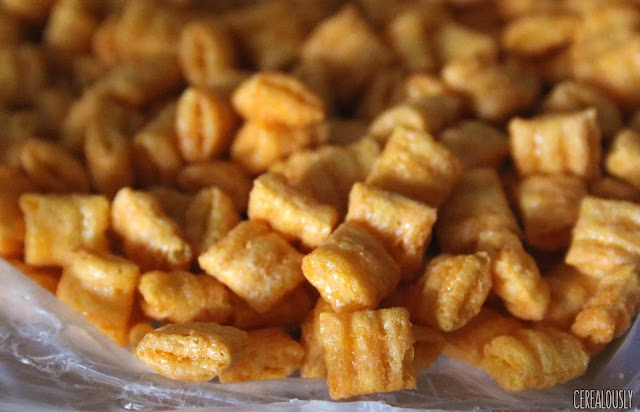In the early 1960s, kids' breakfast choices were a battlefield of sweet kids' cereal brands. So much so that grocery stores strategically placed kids' cereals on eye-level shelves while they sat in the shopping cart. They would throw a temper tantrum until the box they wanted was placed in the shopping cart.
Quaker Oats (acquired by PepsiCo) developed Captain Horatio Magellan Crunch
cereal in 1963.
cereal in 1963.
The bold captain of the Sea of Milk had launched his flagship cereal, golden pillow-shaped nuggets of corn and oats. The cereal was then coated in oil to add flavor. For it to work and remain crunchy, even in milk, the pieces must be baked. Cap’n Crunch very well may have been the first cereal brand to use this oil flavor and baking process.
This flavor creation was first developed by Pamela Low, a flavorist who helped create the specific flavor of Cap’n Crunch that we know today. A significant portion of the history of Cap’n Crunch cereal's creation is attributed to Pamela Low, who was labeled the “Mother of Cap’n Crunch” after her passing.
Veteran TV comedy writer Allan Burns, already renowned as co-creator of hits like "The Munsters" and "The Mary Tyler Moore Show," conceived the maritime cartoon captain in 1963.
Early television advertisements featuring the Cap'n sprang from the wildly imaginative Jay Ward Productions, the animation upstart behind the smash series "The Rocky & Bullwinkle Show."
sidebar
Cap’n Crunch Original 1963 TV Commercial --> https://tinyurl.com/26tvbm4h
There is even an apparent story behind the captain. His name was Horatio Magellan Crunch. He sailed the Sea of Milk, and his true home was Crunch Island. A well-thought-out storyline from beginning to end.
Whistles randomly packed in Cap'n Crunch cereal boxes as toy prizes in the 1960s unexpectedly enabled revolutionary acts of "phone phreaking." These whistles could emit a precise 2600 hertz tone, exploiting a technological vulnerability in telephone networks.
 |
| Cap'n Crunch Bo'sun Whistle |
The obscure capability allowed whistleblowers to make free long-distance calls, an achievement that earned John Draper notoriety as "Captain Crunch" among early hacking circles. Though a seemingly innocuous cereal bonus, these whistles formed Cap'n Crunch's unlikely connection to tech activism and the controversial dawn of a hacking culture.
A curious naval discrepancy emerged in 1963 when Quaker Oats launched Cap'n Crunch, adorning the mascot's sleeve with three stripes—the insignia of a Commander, not a Captain.
sidebar
John Thomas Draper (born March 11, 1943), also known as Captain Crunch, Crunch, or Crunchman after a toy boatswain's call whistle (Bo'sun Whistle) once given away in boxes of Cap'n Crunch cereal that for some years could be used to make free long-distance telephone calls. Draper was an American computer programmer and former phone phreak.
But there was a problem. A sharp problem. A damn bloody problem!
Children across America were emerging from breakfast with shredded palates, their mouths ravaged by jagged cereal corners. Dentists were concerned. Parents wept. The Cap’n, oblivious, kept shouting, “It stays crunchy, even in milk!”—as if that was a virtue.
The original slogan of the cereal was “It’s got corn for crunch, oats for punch, and it stays crunchy even in milk.” And these descriptors were accurate.
The Cap'n Crunch boxes claimed nine servings per container, but I only got four servings per box. After finishing the second bowl, all I could taste was blood.
Cap’n Crunch cut the cereal bits to half the size of the original cereal bits—still sharp, but now less likely to puncture a uvula.
sidebar
"Chrunchatize Me Cap’n!" -- With 33 grams of Carbohydrates, 290 mg of Sodium, and 16 grams of Total Sugar per serving (and... who only ate one serving?), children would get a burst of energy before being taken to the hospital or sent home from preschool.
Enter the Peacekeepers: Quisp & Quake
Quaker Oats, fearing a class-action lawsuit from the American Association of Roof-of-Mouth Victims, summoned the cartoon gods Jay Ward and Bill Scott (of Rocky & Bullwinkle fame). Their mission was to create gentler cereal champions that could deliver the same flavor without the oral carnage.
QUISP: A pink alien from Planet Q, shaped like a flying saucer and powered by “Quazy Energy.” His cereal bits were round, smooth, and UFO-like—designed to glide across gums like diplomatic emissaries.
QUAKE: A burly miner from Earth’s core, whose gear-shaped cereal was engineered to be crunchy but less stabby than Cap’n Crunch. He promised “earthquake power” without dental destruction.
The Captain’s Retaliation: Crunch Berries
The Cap’n, wounded by criticism but unwilling to surrender his crunch, made a strategic pivot. Then, in a stroke of fruity genius, he introduced Crunch Berries in 1967: spherical, berry-flavored puffs that softened the blow (literally).
These colorful orbs acted as cereal airbags, cushioning the impact of the jagged edges of the pillow shapes. The Crunch Berry Beast was hired to distract children from the trauma with psychedelic antics.
The Breakfast Ballot Box
In 1972, Quaker held a cereal election. Kids were asked to vote: Quisp or Quake? The loser would be discontinued. Quisp won. Quake was sent back to the mines, only to briefly reemerge with an orange kangaroo named Simon and a citrus-flavored cereal called Quangaroos.
That, too, was buried in the cereal graveyard.
Dr. Neil Gale. Ph.D.
Cap’n Crunch Box Covers
























































